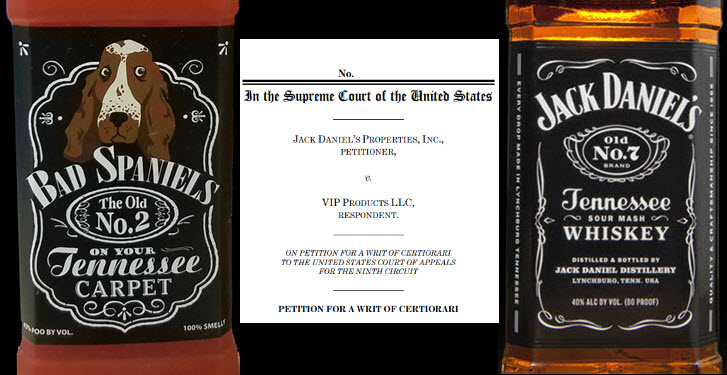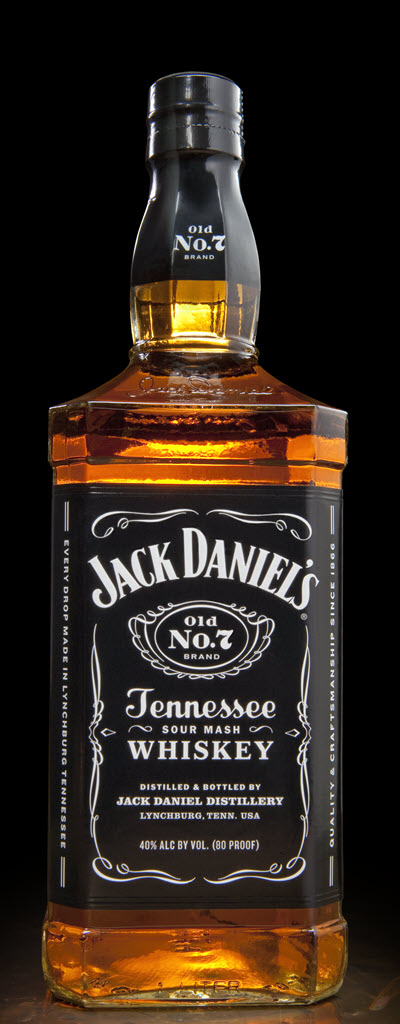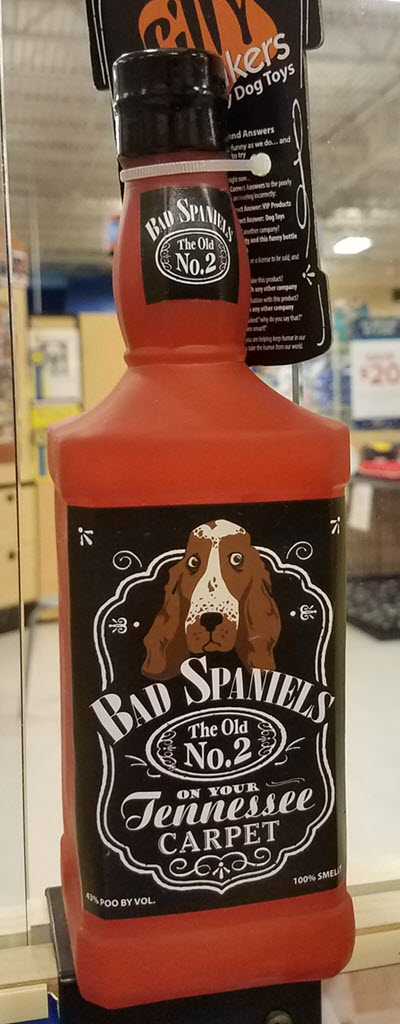
On March 23, 2023, the Supreme Court heard the case of Tennessee whiskey maker Jack Daniel’s v. VIP Products, the makers of Silly Squeakers dog toys. If you listened to the arguments, you had no idea which way the case would go until now. In a unanimous opinion, the Supreme Court sided with Jack Daniel’s.
Silly Squeakers makes a line of dog toys that have an uncanny resemblance to many well-known beer and spirits brands. The manufacturer claims the alcohol brand owners are barking up the wrong tree as it’s all in good fun and does not infringe their products. After nearly three months the Supreme Court has barked back at the squeaky toy maker and told them to sit, stay and drop the toy.
In January 2023, six beer and wine associations including the American Craft Spirits Association – ACSA, American Distilled Spirits Alliance – ADSA (DBA: The Presidents’ Forum of the Distillery Spirits Industry – PFDSI), The Beer Institute, The Brewers Association, Distilled Spirits Council of the United States – DISCUS, and Wine Institute disagree and have filed an Amicus Brief to put a halt to the toy maker from using their brand likeness. It now appears their efforts have paid off.

DISCUS released a statement with the Court’s finding that says, “In a unanimous opinion, the Supreme Court today sided with Jack Daniel’s in an important trademark case regarding a line of dog toys with unsavory themes that imitate well known alcohol brands.”
“While this case focused on silly dog toys, the issue of trademark infringement is very serious and this unanimous ruling is a big win for brand owners working hard to responsibly market their products,” said Courtney Armour, Distilled Spirits Council Chief Legal Officer. “The justices fully understood that consumer confusion is a critical point of analysis and should not be circumvented just because something is arguably funny. This ruling ensures that companies will be able to control their trademarks to ensure responsible advertising initiatives are effective and succeed.”


Stay Informed: Sign up here for the Distillery Trail free email newsletter and be the first to get all the latest news, trends, job listings and events in your inbox.
Related Stories
– Jack Daniel’s Whiskey v. Bad Spaniels Squeaky Toy Trademark Dispute Goes to the Supreme Court March 22, 2023 (Includes the audio from the Supreme Court.)
– This Amicus Brief Stinks: Jack Daniel’s (40% ALC BY VOL) v. Bad Spaniels (43% POO BY VOL) Going to Supreme Court (Includes the actual brief.)
– What is an Amicus Brief / amicus curiae?
Below is an excerpt from the Supreme Court’s finding. Further down on the page is the full 27 page report with comments by each Supreme Court Justice.
SUPREME COURT OF THE UNITED STATES
JACK DANIEL’S PROPERTIES, INC. v. VIP PRODUCTS LLC
CERTIORARI TO THE UNITED STATES COURT OF APPEALS FOR THE NINTH CIRCUIT
No. 22–148. Argued March 22, 2023—Decided June 8, 2023
The Lanham Act, the core federal trademark statute, defines a trademark by its primary function: identifying a product’s source and distinguishing that source from others. In serving that function, trademarks help consumers select the products they want to purchase (or avoid) and help producers reap the financial rewards associated with a product’s good reputation. To help protect trademarks, the Lanham Act creates federal causes of action for trademark infringement and trademark dilution. In a typical infringement case, the question is whether the defendant’s use of a mark is “likely to cause confusion, or to cause mistake, or to deceive.” 15 U. S. C. §§1114(1)(A), 1125(a)(1)(A). In a typical dilution case, the question is whether the defendant “harm[ed] the reputation” of a famous trademark. §§1125(c)(2)(A), (C).
Respondent VIP Products makes a squeaky, chewable dog toy designed to look like a bottle of Jack Daniel’s whiskey. But not entirely. On the toy, for example, the words “Jack Daniel’s” become “Bad Spaniels.” And “Old No. 7 Brand Tennessee Sour Mash Whiskey” turns into “The Old No. 2 On Your Tennessee Carpet.” These jokes did not impress petitioner Jack Daniel’s Properties, which owns trademarks in the distinctive Jack Daniel’s bottle and in many of the words and graphics on its label.
Soon after the Bad Spaniels toy hit the market, Jack Daniel’s demanded that VIP stop selling it. VIP filed suit, seeking a declaratory judgment that Bad Spaniels neither infringed nor diluted Jack Daniel’s trademarks. Jack Daniel’s counterclaimed for infringement and dilution. At summary judgment, VIP argued that Jack Daniel’s infringement claim failed under the so-called Rogers test—a threshold test developed by the Second Circuit and designed to protect First Amendment interests in the trademark context. See Rogers v. Grimaldi, 875 F. 2d 994. When “expressive works” are involved, VIP contended, that test requires dismissal of an infringement claim at the outset unless the complainant can show either (1) that the challenged use of a mark “has no artistic relevance to the underlying work” or (2) that it “explicitly misleads as to the source or the content of the work.” Id., at 999. Because Jack Daniel’s could not make that showing, VIP claimed, the Lanham Act’s statutory “likelihood of confusion” standard became irrelevant. And as for the dilution claim, VIP urged that Jack Daniel’s could not succeed because Bad Spaniels was a parody of Jack Daniel’s and therefore made “fair use” of its famous marks. §1125(c)(3)(A)(ii).
The District Court rejected both of VIP’s contentions for a common reason: because VIP had used the cribbed Jack Daniel’s features as trademarks—i.e., to identify the source of its own products. As the District Court saw it, when another’s trademark is used for “source identification,” Rogers does not apply, and instead the infringement suit turns on likelihood of confusion. The court likewise rejected VIP’s invocation of the fair-use exclusion, holding that parodies fall within that exclusion only when they do not use a famous mark to identify the source of the alleged diluter’s product. The case proceeded to a bench trial, where the District Court found that consumers were likely to be confused about the source of the Bad Spaniels toy and that the toy’s negative associations with dog excrement (e.g., “The Old No. 2”) would harm Jack Daniel’s reputation. The Ninth Circuit reversed. Finding the infringement claim subject to the threshold Rogers test, the Court of Appeals remanded the case to the District Court to decide whether Jack Daniel’s could satisfy either prong of that test. And the Court of Appeals awarded judgment on the dilution claim to VIP, holding that because Bad Spaniels parodies Jack Daniel’s, it falls under the “noncommercial use” exclusion. §1125(c)(3)(C). On remand, the District Court found that Jack Daniel’s could not satisfy either prong of Rogers, and so granted summary judgment to VIP on infringement. The Court of Appeals summarily affirmed.
Held:
1.When an alleged infringer uses a trademark as a designation of source for the infringer’s own goods, the Rogers test does not apply. Pp. 10–19.
(a) The Second Circuit created the Rogers test for titles of “artistic works” based on its view that such titles have an “expressive element” implicating “First Amendment values” and carry only a “slight risk” of confusing consumers about the “source or content” of the underlying work. 875 F. 2d, at 998–1000. Over the decades, lower courts adopting Rogers have confined it to similar cases, in which a trademark is used not to designate a work’s source, but solely to perform some other expressive function. See, e.g., Mattel, Inc. v. MCA Records, Inc., 296 F. 3d 894, 901 (use of the Barbie name in band’s song “Barbie Girl” was “not [as] a source identifier”). The same courts, though, routinely conduct likelihood-of-confusion analysis in cases where trademarks are used as trademarks—i.e., to designate source. See, e.g., Tommy Hilfiger Licensing, Inc. v. Nature Labs, LLC, 221 F. Supp. 2d 410, 414–415 (parodic pet perfumes did not trigger Rogers because defendant’s use of Tommy Hilfiger’s mark was “at least in part” for “source identification”). Thus, whatever Rogers’ merit—an issue on which this Court takes no position—it has always been a cabined doctrine: It has not insulated from ordinary trademark scrutiny the use of trademarks as trademarks.
That conclusion fits trademark law, and reflects its primary mission. Consumer confusion about source—trademark law’s cardinal sin—is most likely to arise when someone uses another’s trademark as a trademark. In such cases, Rogers has no proper application. Nor does that result change because the use of a mark has other expressive content. Under the Ninth Circuit’s approach, Bad Spaniels was automatically entitled to Rogers’ protection because it “communicate[d] a humorous message.” 953 F. 3d 1170, 1175. On that view, few trademark cases would ever get to the likelihood-of-confusion analysis. And the Ninth Circuit was mistaken to believe that the First Amendment demanded such a result. When a mark is used as a source identifier, the First Amendment does not demand a threshold inquiry. Pp. 10–17.
(b) In this case, VIP conceded that it used the Bad Spaniels trademark and trade dress as source identifiers. And VIP has said and done more in the same direction with respect to Bad Spaniels and other similar products. The only question remaining is whether the Bad Spaniels trademarks are likely to cause confusion. Although VIP’s effort to parody Jack Daniel’s does not justify use of the Rogers test, it may make a difference in the standard trademark analysis. This Court remands that issue to the courts below. Pp. 17–19. 2. The Lanham Act’s exclusion from dilution liability for “[a]ny noncommerical use of a mark,” §1125(c)(3)(C), does not shield parody, criticism, or commentary when an alleged diluter uses a mark as a designation of source for its own goods. The Ninth Circuit’s holding to the contrary puts the noncommercial exclusion in conflict with the statute’s fair-use exclusion. The latter exclusion specifically covers uses “parodying, criticizing, or commenting upon” a famous mark owner, §1125(c)(3)(A)(ii), but does not apply when the use is “as a designation of source for the person’s own goods or services,” §1125(c)(3)(A). Given that carve-out, parody is exempt from liability only if not used to designate source. The Ninth Circuit’s expansive view of the noncommercial use exclusion—that parody is always exempt, regardless whether it designates source—effectively nullifies Congress’s express limit on the fair-use exclusion for parody. Pp. 19–20.
953 F. 3d 1170, vacated and remanded.
KAGAN, J., delivered the opinion for a unanimous Court. SOTOMAYOR, J., filed a concurring opinion, in which ALITO, J., joined. GORSUCH, J., filed a concurring opinion, in which THOMAS and BARRETT, JJ., joined.
Below is the full finding of the Supreme Court.
Please help to support Distillery Trail. Sign up for our Newsletter, like us on Facebook and follow us on Instagram and Twitter.




